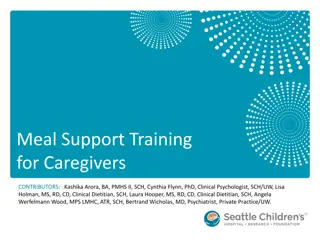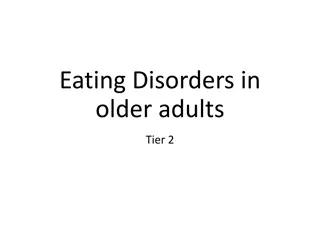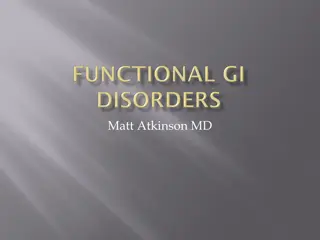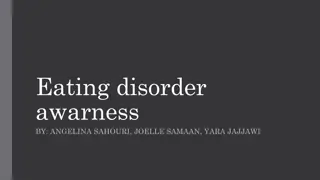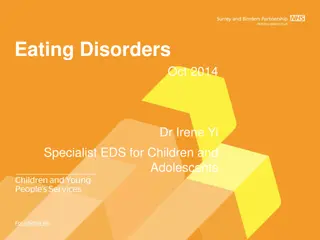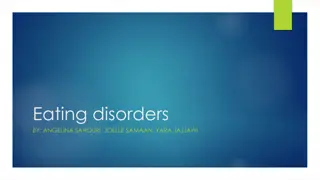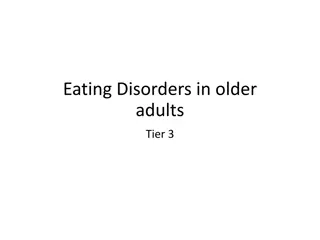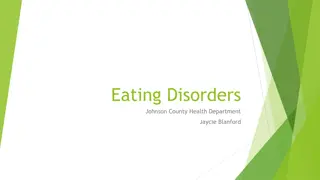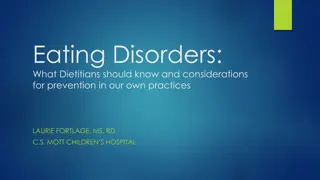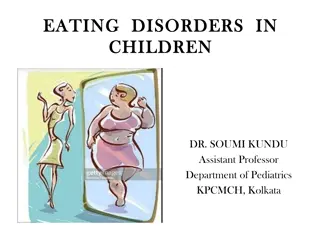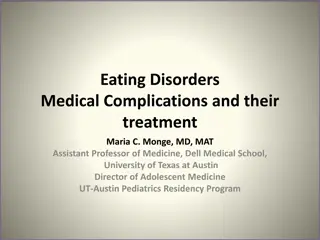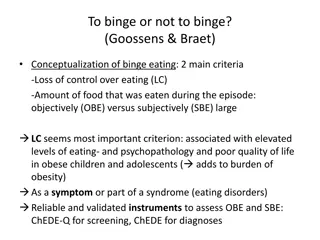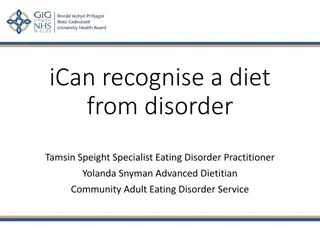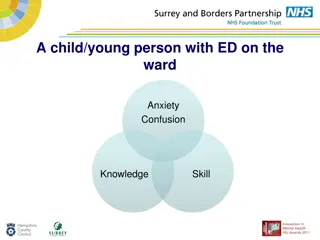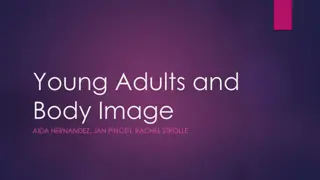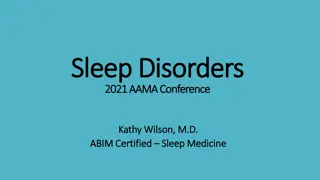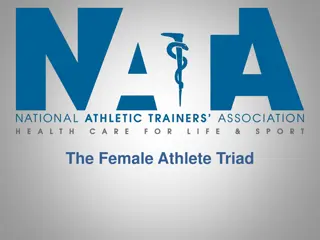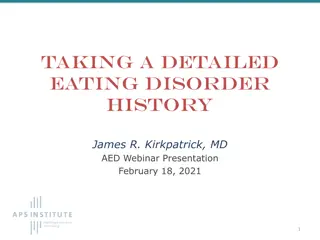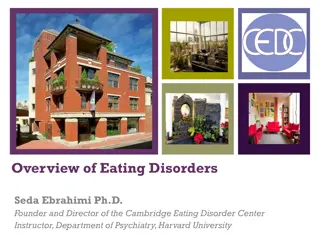Eating Disorders: A Personal and Clinical Perspective
This insightful content delves into eating disorders from a personal narrative and clinical standpoint, covering Anorexia Nervosa, Bulimia Nervosa, and Eating Disorder Not Otherwise Specified (EDNOS). It provides criteria for each disorder, facts, and statistics, shedding light on the challenges, impact, and treatment of these conditions.
Download Presentation

Please find below an Image/Link to download the presentation.
The content on the website is provided AS IS for your information and personal use only. It may not be sold, licensed, or shared on other websites without obtaining consent from the author.If you encounter any issues during the download, it is possible that the publisher has removed the file from their server.
You are allowed to download the files provided on this website for personal or commercial use, subject to the condition that they are used lawfully. All files are the property of their respective owners.
The content on the website is provided AS IS for your information and personal use only. It may not be sold, licensed, or shared on other websites without obtaining consent from the author.
E N D
Presentation Transcript
Eating Disorders A personal and clinical perspective Juliana Hill, B.A.
-My Story--a brief account how it began Evolution Remission Evolution current status: currently in recovery, gained weight, out of the underweight BMI, daily/sometimes hourly battle; in therapy; refuse to take stimulant; two steps forward one step back ***note on cross-addiction up to 50% of women with eating disorders are also addicted to alcohol, drugs,etc. I am an alcoholic in full remission and a recovering shopping addict
AN, BN, EDNOS -Different types of Eating Disorders/clinical criteria 3 types of eating disorders listed in the Diagnostic and Statistical Manual IV: Anorexia Nervosa, Bulimia Nervosa and Eating Disorder Not Otherwise Specified
AN --Anorexia criteria and information Individuals with AN weigh less than 85% of the weight that is considered normal for their age and height (criterion A), they intensely fear gaining weight or becoming fat (criterion B), the experience and significance of body weight and shape are distorted in these individuals (criterion C) and postmenarcheal women experience amenorrhea (criterion D) Some facts: (from October 14, 2008 presentation given by Benek Altayli, Psy. D.) 1/200 people living in the United states will develop AN 90% of sufferers are women Diagnosis occurs most often in puberty or age 18 50-75% of sufferers also have major depression 25% have OCD 5% die from the disorder Less than 40% recover spontaneously 70% can be helped with competent treatment
BN -Bulimia Nervosa Individuals with BN engage in binge eating, defined as consuming an amount of food in a discreet period of time (approx 2 hours) that is definitely larger than most individuals would consume under similar circumstances (criterion A1), the episode of binge eating is accompanied by a sense of lack of control (criterion A2), the individual engages in a recurrent use of compensatory behaviors to prevent weight gain, such as induced vomiting or the misuse of laxatives and diuretics (criterion B), the binge eating and inappropriate compensatory behaviors occur an average of two times a week for a period of at least three months (criterion C), individuals suffering BN place an excessive emphasis on body shape and weight in their self-evaluation and these factors are typically the most important ones in determining self-esteem (criterion D) Some facts: (Benek Altayli, Psy. D.) BN affects 3%-10% of adolescent and college age women in the US 25% are initially anorexic Commonly co-occurs with affective disorders, impulse control disorders, BPD, PTSD symptoms, and substance abuse Successful outcome of treatment is negatively impacted by familial obesity
EDNOS -Eating Disorders Not Otherwise Specified This category is for disorders of eating that do not meet criteria for any specific eating disorder
-Possible reasons for eating disorders (Benek Altayli, Psy. D) Genetic-many researchers believe there is an inherited predisposition to having an eating disorder. Studies have shown that the co-occurrence among identical twins is greater than fraternal twins Chemical-the neurotransmitters serotonin and norepinephrine have also been identified as being significantly decreased in acutely ill patients suffering from Anorexia and Bulimia as well as Depression and PTSD; these neurotransmitters create a sense of physical and emotional satisfaction as well as signal fullness and food satisfaction. Hormones-individuals with eating disorders have been shown to have higher levels of the hormones vasopressin and cortisol than the general population; these hormones are normally released in response to physical and possible emotional stress, and may contribute to some of the dysfunction seen in eating disordered individuals. Environmental-we live in a society that reinforces the idea that to be happy and successful we must be thin; we are assaulted by magazines, newspapers, television and radio with the message that fat is bad; other societal issues include dysfunctional families, sexual abuse, physical abuse, domineering coaches and controlling relationships Psychological-the practice of an eating disorder can be viewed as a survival mechanism, an individual with an eating disorder can use eating, purging or restricting to deal with feelings and emotions that may otherwise seem overwhelming; thru the use of an eating disorder an individual may a sense of partial control over their seemingly incontrollable life. Underlying issues-some of the issues that are associated with an eating disorder are low self-esteem, depression, feelings of loss of control, feelings of worthlessness, identity concerns, family communication problems and an inability to cope with intense emotions; the practice of an eating disorder may be an expression of something that the individual has found no other way of expressing
-Father Hunger book by Margo Maine,Ph.D, originally published early 90s, revised 2004 Father hunger is a deep, persistent desire for emotional connection with the father that is experienced by all children. --unfulfilled longing for the father that for girls and women often translates into conflicts about food and weight; when this normal craving is satisfied, children are likely to grow up feeling confident, secure, strong, and good enough.
-Father Hunger Girls may adopt the if only I were skinny approach to escape pain and reduce all their negative emotions into simply feeling fat. Problems encountered in eating disordered patients, chronic dieters, over exercisers, and weight preoccupied women have little to do with weight and food those are merely symptoms for deeper issues rooted in pain and confusion, as the individual reaches for self esteem and identity while dealing with depression, anxiety, fear, trauma and disappointment.
-Father Hunger Global Girls-Maine coined this phrase to describe the effects of globalization on today s young women. These largely negative effects are due to the unprecedented access to and influence of the media via communications and world markets as well as mobilization. This increased mobility means more opportunities to explore the external and superficial while less emphasis is placed on developing an internal sense of one s true self, complicating the task of forging a personal identity in a culture where moral authority, traditions, and core values are not valued.
-Father Hunger Encouraged to look outside themselves for comfort, values and direction, global girls fall easy prey to addictive behaviors and unrealistic images that are promoted in various advertising media. By imposing impossible standards to keep women of all ages unsure, uneasy and in their place, the mass media relentlessly pressure global girls to be someone other than who they are naturally. By default they develop a false self, constantly focusing on the outside, expressing their femininity through their appearance rather than their actions, accomplishments, feelings and relationships.
-Disordered eatingwhat does it look like? restriction calorie counting eliminating food groups rigid adherence to a given eating routine lack of variety ritualistic
-Healthy Lifestyle Exercise (up to 90/min a day) 3 meals, 3 snacks water fun/pleasure/treats BALANCE
-Eating Disorder resources for recovery Eating Disorders Support Groups Individual Therapy University Counseling Center-255-3265
-Eating Attitudes Test For anyone who has a concern that they may be at risk, there is an Eating Attitudes Test that you can take anonymously on line that will tell you your risk level ***if you ARE concerned, it is highly recommended you see a professional




